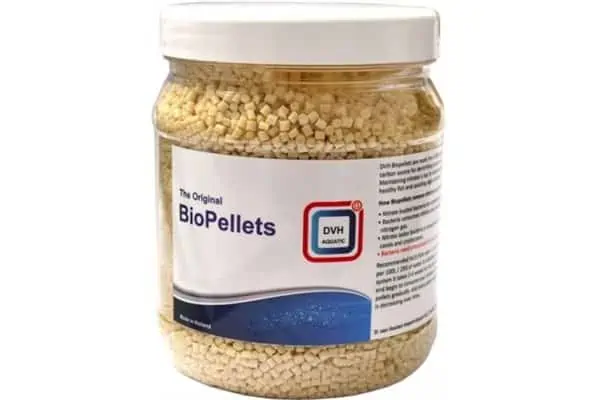The Original BioPellets
€18,50 – €57,50
DvH The Original BioPellets will allow aerobic growth of bacteria which consequently will consume nitrate and phosphate simultaneously
DvH The Original BioPellets will allow aerobic growth of bacteria which consequently will consume nitrate and phosphate simultaneously
The Original BioPellets have a positive impact on water quality based on the principle of immobilization. Essentially, waste products in the water, particularly nitrate and phosphate, are transformed into bacteria, which helps keep your aquarium water clean.
These pellets are made from 100% pure biologically degradable polymers and can easily be placed in a fluidized filter or filter canister. They promote aerobic growth of bacteria, which, in turn, consume both nitrate and phosphate at the same time. The bacteria utilize the carbon from the BioPellets while extracting nitrogen and phosphorus from the water in the form of nitrate and (ortho)phosphate. This process of converting organic BioPellets into microbial biomass is known as immobilization. Additionally, anaerobic layers will form, leading to further denitrification.
As bacteria multiply, they are consumed by filter feeders and suspension feeders such as sponges and corals, or they can be skimmed off by a protein skimmer. On average, this “solid vodka method” takes about 2-4 weeks to generate enough bacteria, allowing nitrate and phosphate levels to decrease. One key advantage of using The Original BioPellets over vodka or sugar as a carbon source is that they foster localized bacterial growth in the filter compartment rather than throughout the entire aquarium, where they might clog pipes and hoses. Furthermore, they help prevent the growth of cyanobacteria by allowing bacteria on the BioPellets to compete with these troublesome microbes. Lastly, The Original BioPellets save aquarists valuable time since there is no need for daily carbon dosing.
It is important to note that The Original BioPellets consist of 100% pure biologically degradable polymers and contain no fillers or antioxidants that could be harmful to your aquatic animals. Please be aware that color and shape may vary with each batch.
How it works:
The Original BioPellets are consumed by bacteria, which is why it is necessary to add new pellets every 6-12 months to compensate for the substrate that has been digested. You can observe when this is needed by inspecting the filter or noticing an increase in nitrates. These measurements will depend on the specific conditions of your aquarium and are greatly influenced by feeding habits and livestock. It is advisable to take regular measurements of both nitrate and phosphate levels, allowing you to adjust dosages as needed.
It is noteworthy that The Original BioPellets have a higher molecular mass compared to many competing products, resulting in a longer filter retention time and requiring less frequent refills than other low molecular weight products available on the market. We recommend positioning the outlet of the pellet filter in front of a protein skimmer to control the amount of bacteria entering the system. This setup also enhances gas exchange, helping to remove CO2 and add O2.
Please ensure that the pellets are used with adequate aeration to avoid low oxygen and pH levels, especially at night. Proper aeration can be achieved with air pumps and protein skimmers. While The Original BioPellets allow for increased feeding and, consequently, more livestock, heavy feeding may necessitate combining the pellets with standard phosphate adsorbents or substituting them with the All-in-One Advanced BioPellets. This is because most aquarium feeds contain higher levels of phosphate than can be consumed by bacteria, fish, and invertebrates when compared to nitrogen. Some phosphate adsorbents can deplete alkalinity and lower pH levels, but using phosphate adsorbent media based on iron hydroxide avoids this issue.
Note:
Your system must contain phosphates (PO4) to effectively reduce nitrates (NO3). The recommended NO3:PO4 ratio is 1:0.01. If your nitrates exceed 20 ppm, it is essential to maintain minimum phosphate levels of 0.08 ppm or higher. This can be achieved by increasing feeding, removing phosphate-absorbing media, or adding phosphate.

